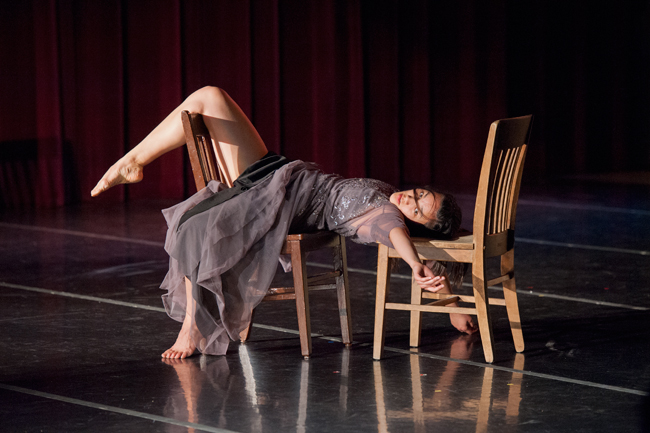
CC Chiu, Nia-Amina Minor, IJ Espinoza and Gary Champi rehearse a section from Rooms.
L.A. CiceroStanford Dance reconstructs Anna Sokolow’s signature work Rooms
Artistry, artifacts and scholarship come together in a dance history project presented by Stanford Dance, the Clayman Institute for Gender Research and Stanford Hillel.
On February 9 at 7 p.m. and again at 9 p.m., an American dance masterpiece comes to life. Anna Sokolow’s Rooms (1955), featuring music composed by Kenyon Hopkins for a jazz ensemble, is a powerful portrayal of the terrifying loneliness that afflicts even people living in the closest proximity to each other. Dr. Hannah Kosstrin, an assistant professor and dance scholar at Reed College, will preface the performance with a lecture, and the event concludes with a brief discussion.
The Rooms project was prompted by a photography installation, Sokolow in Israel, which spans three decades in Sokolow’s career. The exhibition is currently on display at Hillel at Stanford through March. Janice Ross in the Drama Department arranged for the photos to come to Stanford and she collaborated with Diane Frank, the acting director of Stanford Dance, to stage a reconstruction of Sokolow’s masterwork Rooms. This event is part of the series of satellite events organized as part of the “Ms. @ 40 and the Future of Feminism” symposium.

L.A. Cicero
To reconstruct a dance means to set a previously performed dance work, in all its performative dimensions, on a new cast of dancers, Frank said.
“The staging director teaches the movement – spacial patterns, rhythms and dynamics, partnering, and special vocabulary specific to the work and characteristic of the period or specific choreographer – sometimes with the aid of notation, video or film. Often, the staging director has danced the roles and has a clear kinetic memory of the movement. She plots out the work in relation to the score, and more importantly, she coaches the dancers in nuances of approach and execution.
“She uses rehearsal techniques originally employed by the choreographer in order to summon the performance qualities of the original. The hard part is directing the dancers so that they connect to the kinetic spirit and intent of the dance with fidelity to the original in the immediate moment. A great staging director – and Lorry May is one of them – gets beyond the steps immediately and gets the dancer to connect to the truth in the movement. It is an art.”
Lorry May, the director of the Sokolow Now! archival dance company and reconstruction specialist with the Sokolow Dance Foundation, danced with Sokolow for many years. She came to Stanford twice for intensive sessions with the dancers in January. Frank, the rehearsal director for the project, has been holding group rehearsals and separate soloist work.
“The number of hours logged is not the important thing; rehearsal intent is. How we rehearse is crucial,” said Frank. “It is fair to characterize the lengthy rehearsals as both challenging and transformative for the Stanford dancers. They have had to deliver at 110 percent in every way – physically, emotionally and mentally – to connect with this work. The issue of reconstruction – how to make a dance work come alive – really gets at what dance is about.”
Tonight’s performance features eight dancers: Gary Champi, CC Chiu, Gabriela Leslie, Tessaly Jen, Nia-Amina Minor, IJ Espinoza, Myrton Wesley Running Wolf and Ellery Alyosha Wulczyn. Costume construction is by Samantha Burpee and lighting is by Tony Kramer.
Sokolow was fearless in her belief in art as a force for social change and justice.
She was a powerful individualist even among the first generation of great American dance artists, such as Martha Graham (with whom she danced before setting out on her own), the partners Doris Humphrey and Charles Weidman, and José Limón. Her work was groundbreaking in both form and content. She was a consummate formal choreographer who sourced movement from the immediate present and reduced it to an essential kinetic image, powerfully expressed and universally understood.
Anna Sokolow’s career
Born in 1910 into a working-class Jewish family with a mother who was strongly rooted in union activity and progressive politics, Sokolow possessed a driving sense of social justice and a commitment to political change. All of this found expression in her powerful artistic statements that often examined difficult topics.
Sokolow began her training at the Neighborhood Playhouse with Martha Graham and Louis Horst. In the 1930s she was a member of the Graham Dance Company and assisted Horst in his dance composition classes. During this period, Sokolow formed her own company and began choreographing and performing solo concerts and ensemble works. Her vast range of repertory includes drama, comedy and lyricism with her commentaries on humanity and social justice threaded into each of her works.
She was instrumental as a teacher and choreographer in the development of a national dance in both Mexico and Israel. In the United States, she worked at the intersection of the most progressive dance, theater, Broadway, television and concert forms. She was the first to use jazz as the score for a serious concert work.
Her seven decades of choreographing and teaching influenced the direction of American dance and theater, and her mark on generations of dancers and actors is indelible. She was known for her fierce dedication to justice and to the highest demands of her art form, and her work is beautiful in its unflinching examination of serious themes. Sokolow died in 2000 at the age of 90.
